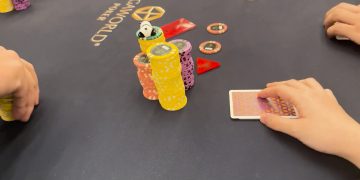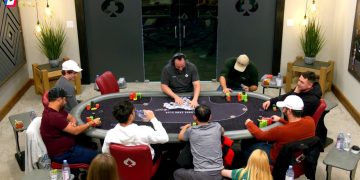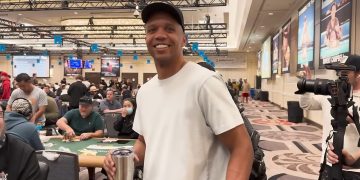I recently made a hybrid trip to Florida: hybrid in the sense that it was half vacation/half poker. Since I write when I’m home and play poker when I’m on the road, some people tell me that I never take a vacation, but poker feels like a vacation to me, even though that’s not the case when I’m approaching the bubble, abandoning my poker strategy and hanging on to my chips with dear life.
Buy-In Amount Is A Tell
Prior to this trip, I had seen the Tampa Hard Rock as the toughest poker room in the country, but that’s because I was playing higher buy-in tournaments. Based on my experience, I should have recognized that the buy-in amount directly relates to the quality of the competition at any location. This is why I love the $135 Nightly tournaments on the WSOP Circuit. Some people think you can’t beat the rake, but you sure can. If you know all you have to do is sit back and wait for half the field to make terrible decisions, you’re going to do alright.
Poker Flights Matter

As far as the Little Slick $200k Guarantee tournament goes, it was a good experience because it was the first time in two months I finally felt like I was back on my game. Did I have anything to show for it? I’m going to keep you in suspense on that. What I can tell you at this point is that this event drew a massive 2,111 players.
Those are WSOP Circuit-type numbers for the Re-Entry. The difference is that since this was a $200 buy-in opposed to a $400 buy-in for the WSOP Circuit Re-Entry, the payouts were much lower. Not only that, the payout was very top heavy. In other words, you needed to make the final table to make any real money.
The Tampa Hard Rock was able to attract this many players because they had 14 flights, two flights per day on seven different days. If you played during the week like I did—I played on a Wednesday—then your field wasn’t very big. This can be good and bad. It’s a good poker strategy in the sense that it’s easier to find a bag for Day 2, but it’s a bad poker strategy in the sense that there won’t be as many chips in play, which means you’re not likely to bag as many chips as those who played on Friday and Saturday (Day 2 was Sunday).
There is another Day 1 factor when it comes to all poker tournaments. If there are multiple flights and some of those flights are during the day on a weekday, that competition is going to be tougher because many of those players are at their job—they’re sitting at a poker table.
Multiple Flights
If there are multiple flights for a poker tournament, there will almost always be flights on Friday and Saturday. These flights will always draw softer fields. However, this can be tricky because some of the softer players are gamblers that don’t know what they’re doing, which makes them difficult to read.
For instance, you might 3.5x the Big Blind from Under the Gun (UTG) and a bad player in middle position will call with 8s 4h. This is a terrible call over the long haul, but that bad player might get lucky. A good player never calls with poker hands like that in that spot because they know it’s –EV (Negative Expected Value).
Hard Rock Little Slick $200K GTD Experience
The design of this trip was intended. The goal was to relax two and a half hours south in Bonita Springs prior to driving up to play a poker tournament at the Seminole Hard Rock in Tampa, which I think is the nicest poker room in Florida. Some people say that title belongs to BestBet, but BestBet just looks like a big room to me. The Seminole Hard Rock has a lot more appeal thanks to its high-quality tables and chairs, cleanliness, chandeliers above the tables, snack corner, bar, polite and efficient staff, and great action.
As far as my experience goes, I finally fell back into the zone. When I looked back on my previous play over the past two months, there was one tournament win and overall success in cash games, but there were way too many poker tournament busts. This is supposed to be normal for a tournament poker player, but I do believe that someone who is truly in-tune with the game and follow the correct poker strategy can cash a lot more often. Please allow me to explain.
Overvaluing Hands

Many poker tournament players believe that they have to call with a hand like AT-off when in position. That is false. It should never be automatic. Everything depends on the player who made the bet. What have that player’s betting patterns been? Does this bet fit within those patterns? In most cases, if someone raises from early position and you’re holding AT-off, you’re behind.
Think of it this way: What are you going to do if you hit your Ace and he keeps betting into you? Did you call pre-flop just to fold on the flop? What if the flop is QT8 and he bets into you? Do you really assume that AT is usually good there? There are very few scenarios where you will be holding the winning hand in that spot. If everyone folds and you’re the aggressor with AT-off, that’s a whole different ballgame and a much better situation.
poker strategy -ATo
There are many trouble poker hands, including AT, KQ, AJ, and JJ. These hands are often overplayed, which leads to them going from +EV to –EV. How many times have you seen someone 15x the Big Blind or shove with JJ because they were afraid to play them? If you play poker, then it’s more than a hundred times, and that’s a conservative estimate. That move, by the way, is not good poker strategy.
Changing Gears
JJ should be played like JJ. Always change gears, but for the most part, it should be a standard raise, followed by evaluating the situation on each street. The problem most poker players have is that they get emotionally connected to JJ, thinking they deserve to win the hand simply because they were dealt JJ. It’s just another pre-flop hand. If it doesn’t work out, move on.
You might be in the Big Blind in the next hand with 85-off, it’s limped to you, and you flop a straight. But if you don’t flop that straight, you don’t get emotional about it. Why? Because it’s 85-off. Treat JJ like any other hand and you will be a happier poker player. I just had a friend text me to say he busted late with JJ in a poker tournament yesterday. I didn’t ask about the specifics of the hand because I don’t like bad beat stories, but people grossly overvalue JJ in Texas Hold’em poker tournaments.
Zoning Experience
Getting back to my experience, the reason I was more in the zone is simple: I didn’t care what others thought. Ego was pushed to the side. There were several situations where the book said I was supposed to call, raise, or fold, but I burned the book (in my mind) and played my game. On Day 1, I was playing well and running good (a great combo).
I didn’t accumulate a monster stack, but I bagged 108,000 with the average stack being 145,500. This wasn’t spectacular, but it was the best I could do with the cards I was dealt and the opponents at my table. They weren’t as gamble-oriented as other players in that tournament (from what I was told).
What made this situation unique for me is that I bagged on Wednesday and played Day 2 on Sunday. I had never once before had to wait that long to play a Day 2. I purposely did non-poker-related things. Went out to dinner, went on a dolphin tour boat, swam in the pool, and went to the gym. I didn’t want to think about poker strategy during those three non-poker days.
Pre-Game Poker Strategy

Prior to the tournament, I looked at my table draw. This in itself is a good poker strategy. It allows you to know who is who at your table. You can do this by searching each name on HendonMob. You will see all of their sanctioned poker tournament results. At this specific table, there was only one player with higher earnings than me.
He was also one of three players at the table with more chips than me. The chip leader at my table was a senior citizen who had no earnings. Therefore, I assumed he was a local player who usually played cash in the mornings and played very tight (this ended up being a correct assumption).
Bad Poker Strategy
On the very first hand, the player with higher earnings than me shoved with AJ and got called by another player with AQ. The AQ held. The player with AJ had just shoved for 37.5 Big Blinds with AJ-off in a tournament where first place was paying just over $50,000. He had also invested an entire day on Day 1. This is poor poker strategy and should never be practiced by you!
Bad Fold/Good Fold
On the third hand of Day 2, I was in the Big Blind and peeked down at 54-off. UTG + 1 raised 4x my Big Blind and got called by another player. I folded, then proceeded to watch the flop come: 545. What made this worse was that they kept going at each other.
Look again, though. I’m not saying I would have lost the hand. I would have won a monster pot, but you can’t look at it that way. A bad fold is always better than a bad call, but you can’t look at it as a bad fold because a call there out of poker position would have been –EV.
In simpler terms, you probably hate it when you fold and smash the flop, then watch others go at it. What you’re not realizing is that the vast majority of the time you fold those hands, you would have lost. You just don’t remember those hands as much because everything went as it should have. In other words, if you keep calling a 4x BB raise with 54-off from the Big Blind, you’re going to lose money. There are times to defend your Big Blind, but calling a 4x BB raise from UTG + 1 is not one of them.
Goal #1
I had two more situations like this, which I will admit was slightly frustrating, but I truly don’t get emotional at the table. I remind myself to stick to the game plan. That game plan was patience and pot control. I’m at my best when controlling the situation.
There were 292 runners for Day 2 and 212 got paid. My first goal: get paid. With that goal in mind, I had to fold more often. If I had a monster stack, then I would be attacking at this time. This is the best time for a big stack to attack because most players are playing scared.
This is because they also want to make the money. You will never pick up more chips than the hour before the bubble, but only attempt this if you have a stack and the players at your table are at least relatively passive. Know your opponents and pick your spots. These are basic poker rules for success.
Once in the money, I altered my poker strategy slightly and attacked more often (but not too much). Let me put it to you this way: If you want to win in Texas Hold’em poker tournaments, be patient when everyone else is greedy and be bold when everyone else is patient. While on the topic of poker strategy as well as poker rules for cashing, the stronger your competition, the tighter you should play. The weaker your competition, the more aggressive you should play (within reason).
Going Up/Going Down
Ran my stack up to 160k, but stalled there. I watched the clock more than the table. I always enjoy watching the Players Remaining number decline because as it goes down, my income goes up. Honestly don’t know how my 160k stack became a short stack. It wasn’t one big hand, and I wasn’t being blinded out. It was more of a few moderate pots that slowly did the trick.
Once short-stacked, I shoved with 55. The weakest player at the table tanked and ended up calling with Js 8s. Flop: 277. He said, “You got it.” Once he said that, I knew I was doomed, but I had been there so many times with these kinds of people that it didn’t faze me. Turn: J. River: 3. I busted in 96th for $584.
poker strategy – 55
Incredibly Important Final Thought
It wasn’t a big payday, but my game was back because ego was gone. If there is one poker strategy to follow for tournaments, it’s to ignore everything else and eliminate ego. See you at the WSOP!
♠ pokerjournal.org












Discussion about this post